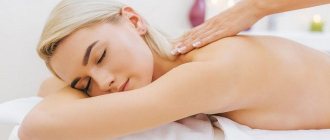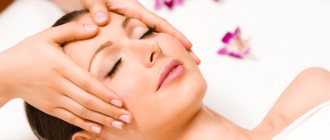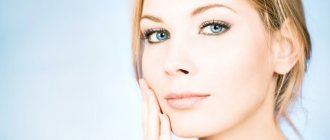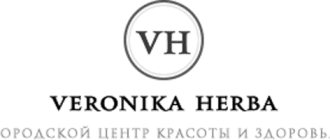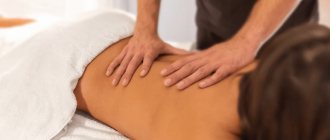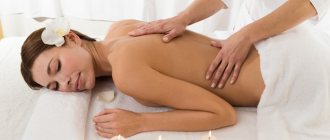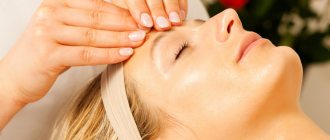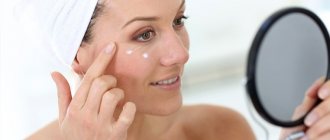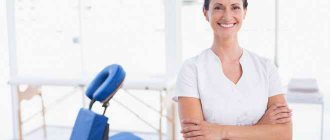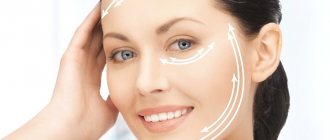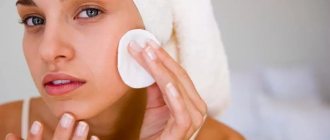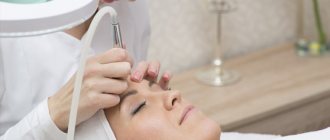Buccal massage is the original technique of the French cosmetologist and biochemist Joëlle Siocco. The trick is that it is performed through the oral cavity. In other words, this is an interoral massage, or, to be even more precise, a cheek massage. The name comes from the Latin word bucca - “cheek”.
The meaning of buccal massage is to intensively work the facial and chewing muscles of the face with a bilateral grip (from the inside and outside), and the purpose of the manipulation is to return the muscles to their original length, tone and elasticity. Using a special technique, the cosmetologist kneads, stretches each muscle and moves tissue, literally “putting the face in place,” which is why buccal massage is also called (and not in vain) non-surgical lifting.
What is buccal massage
Buccal facial massage is a modern massage technique that can improve the condition of the skin and increase the tone of the facial muscles. Its effect is reminiscent of skin lifting and Botox.
The essence of the technique lies mainly in the fact that massage actions are carried out on the outer and inner sides of the face. This technique was developed by French cosmetologist Joëlle Ciocque.
The technology of buccal massage has literally revolutionized all ideas outside of classical skin rejuvenation techniques. Now you can achieve a noticeable facelift without serious intervention: women do not need to turn to plastic surgeons or undergo mesotherapy with “beauty injections.”
Radical surgery can be dangerous to health, but buccal massage is completely safe and can be used by any woman, regardless of age.
Massage in the cheeks and chin area
The massage affects the zygomatic, cheek, chewing, and chin muscles, as well as the muscles that change the position of the lips (the laughter muscle, the levator anguli oris muscle, the depressor anguli oris muscle, the depressor of the lower lip muscle). Particularly important is the effect on the masticatory, pterygoid and temporal muscles, since the quality of movement of the lower jaw, the position of the mouth at rest, and the function of chewing depend on their condition.
Relaxing massage.
- The index fingers of both hands are located under the lower lip, and the rest are under the chin.
- The index fingers of both hands are located above the upper lip, the middle fingers under the lower lip, and the rest under the chin.
- Movement of all fingers (except the thumb) starts from the back of the nose, passes through the zygomatic arch to the auricles, fixing the fingers in the recesses at the tragus and earlobe.
- The movement is carried out with three fingers (index, middle, ring) of both hands from the midline of the forehead down through the temporal cavities to the middle of the chin.
Invigorating massage.
- Circular rubbing in the cheek area is carried out with the dorsal surface of the terminal and middle phalanges of the four fingers in the direction from the edge of the lower jaw to the edge of the zygomatic bone.
- In a similar way, circular rubbing is carried out from the middle of the chin up to the wings of the nose.
- In the area of the masticatory muscle, kneading is performed with spiral movements and circular rubbing.
- The back surface of the middle phalanges, clenched into a fist, shakes the cheeks both longitudinally and transversely.
Types of buccal massage
The technology of massage actions is divided into several types:
- Sculptural . This type combines two directions: buccal and sculptural. Work in this technique is carried out along massage lines and is aimed at working all the muscles of the face.
- Plastic . This type combines an external light effect and an internal intense effect on the maxillofacial muscles and nerve endings.
- Topological . This type of technique includes acupuncture, that is, influencing energy points and active nerve endings.
Each of these types of buccal massage is unique and has its own positive aspects and characteristics. Which one to use is best decided together with a specialist and your doctor. This will allow you to organize your work correctly and achieve high positive results.
Massage in the eye area
The massage affects the orbicularis oculi muscle and the corrugator muscle. The massage is performed with eyes closed. Massage movements in the area of the eye sockets should be very gentle, carried out without much pressure or moving the skin.
- Stroking with the pads of the middle fingers of both hands. Movement from the temporal fossa along the lower edge of the eye to the inner corner of the eye; then up to the eyebrow and then stroking is carried out with the index and middle fingers along the eyebrow to the temple; in this case, the middle finger lies under the eyebrow, and the index finger above the eyebrow
- Stroking the orbicularis oculi muscles. Using the pads of the fourth fingers of both hands, they simultaneously stroke from the temple along the lower eyelid to the inner corner of the eye. Then they smoothly move to the upper eyelid and stroke it very lightly, without pressing on the eyeball.
What is unique about the procedure?
This technique is unique in its non-standard approach. The specialist influences and works the facial muscles simultaneously from two sides: external and internal. The technology of movements in this case is fast and intense, which can sometimes cause discomfort. And yet it is much better and safer than injections or a scalpel.
The huge advantage of this massage is that it:
- effectively tightens the skin;
- removes wrinkles;
- smoothes nasolabial and eyebrow folds;
- increases blood and lymph flow;
- muscle spasm and stiffness are relieved, which allows you to get rid of facial distortion and restore facial expressions;
- corrects the oval, removes excess subcutaneous fat from the cheeks;
- enhances the regeneration of epidermal cells.
All this can be achieved with regular courses of buccal massage.
Forehead massage
Relaxing massage.
- Stroking movements with the palmar surface of all fingers (except the thumb) in the direction:
- from the middle of the forehead to the temporal areas. Circular stroking in the form of a spiral is carried out on the temples
- from the middle of the forehead to the tragus of the auricle, ending with light pressure
- Stroking in the direction from bottom to top, from the brow ridges to the scalp. The movements are carried out alternately by the palmar surface of all fingers of the right and left hands or simultaneously by the pads of the 2nd–4th fingers of both hands.
Invigorating massage.
- Rubbing, i.e. semicircular or spiral movements in the direction from the midline of the forehead to the temples.
- Kneading, squeezing a fold of skin with two fingers - thumb and forefinger, or intermittent pressure.
- Intermittent vibration, or puncturing (tapping), with the pads of the index and middle fingers alternately at a fast pace.
Contraindications
But even with all the advantages, there are limitations to the use of this technique. It should not be used by people:
- with thyroid disorders;
- for oncological diseases;
- with pronounced lesions of the facial skin (scratches, wounds, hematomas);
- in case of an allergic reaction (may occur to latex or components of the cream used);
- during pregnancy.
You should also refrain from performing this massage if you have herpes or other infectious diseases.
LITERATURE.
- Dyakova E.A. Speech therapy technologies Speech therapy massage: textbook. aid for students Ed. Center "Academy" issue-6
- Ogloblina I.Yu., Tantsyura S.Yu. Speech therapy massage: games and exercises.
- Prikhodko O. G. Features of speech therapy work for dysarthria with children suffering from cerebral palsy and other types of neurological pathology // Development and correction. - 1999. - Issue. 5.
- Serbina A.F., Voloskova N.N. A set of techniques for massaging speech and facial muscles for dysarthria. Dysarthria, clinical, neurolinguistic, psychological and pedagogical aspects of the problem: Educational and methodological manual. — Stavropol, 1996
Execution technique
Carrying out buccal facial massage is possible only in specialized cosmetology centers by trained professionals. You will not be able to carry out this procedure on your own . This is due to the fact that it is required to perform movements directly above the person, positioned above or behind.
It is worth understanding that it is impossible to turn around and perform the movements correctly on your own. At the same time, be prepared that if you perform a massage at home, bruises, irritation, and swelling may remain on your face, which will only bring a negative effect. That is why it is worth contacting a specialist who knows exactly how to act and what force to use.
The procedure begins from the nasolabial area, then the movement continues to the inside of the lip and deep into the oral cavity. The facial muscles are small, each of them requires special training with the fingertips to achieve a positive result.
Buccal massage is a sculptural massage, it is aimed at activating and maintaining the tone of the maxillofacial muscles. The procedure takes place in several stages :
- Cleaning and preparing leather . Before starting any type of massage, the skin must be cleansed of dust, dirt, and cosmetics. This procedure is mandatory, since direct contact of dirty skin with hands can lead to infection, and in the case of work in the inside of the mouth, this point becomes very important.
- Warm up . To activate lymph flow, lightly knead the décolleté area, neck and submandibular lymph nodes. Next, the facial muscles are warmed up using pinching and tapping. Work is carried out from the central zone to the periphery.
- Massage movements . The muscles of the mouth are worked first using circular movements. To do this, the thumbs are placed in the inside of the mouth, and the index fingers remain outside. The work is carried out with both hands simultaneously on both sides. This position of the fingers allows you to activate blood and lymph flow in both directions and fill the tissues with oxygen.
- Next, the work is transferred to the nasolabial folds . The movements are performed using the same technique, while slightly stretching the muscles down and to the sides. The cheeks are worked on next. The last to be used are the facial muscles. Working with each muscle, the specialist makes not only stroking movements, but also pinching and tapping with slight pressure.
- The final stage of the massage is general stroking , soothing movements over the entire face, followed by the application of moisturizer. It is better to use professional cosmetics that contain natural ingredients.
The patient's mouth remains open throughout the procedure. The master carefully works each muscle, which causes slight discomfort. But this does not harm health, and adaptation to unpleasant sensations quickly occurs.
All actions of the specialist are carried out wearing protective gloves, which are pre-treated with antiseptic agents.
Note! In the first minutes after the massage, swelling may appear, but it quickly goes away, leaving behind smooth, toned skin.
SHOULDER AND NECK MASSAGE
Relaxing massage. Relaxation of the muscles of the shoulder girdle and neck expands the physiological capabilities of the respiratory apparatus, while the tone of the root of the tongue reflexively decreases, which helps to intensify movements of the lower jaw. The person being massaged should be naked up to half the chest.
- Slowly stroke the front of the neck with the palms of both hands (alternately with the right and then with the left hand) from top to bottom along the side areas of the throat (avoid pressing on the thyroid gland area)
- Slowly stroke the side of the neck, alternately on the right and then on the left.
- Place both hands on the back of the neck, towards the back of the head, this massage technique relieves tone from the trapezius muscle.
Invigorating massage. Massage movements are performed in the direction from bottom to top, using stroking and rubbing techniques. Tapping, kneading and vibration of these sections are contraindicated. 1. The movement is carried out simultaneously or alternately with both hands, up the side surface of the neck to the corners of the lower jaw. 2. The movement begins from the area of the shoulder blades along the posterolateral surface of the neck up to the back of the head.
The effectiveness of buccal massage
After the first sessions of working with the sculptural massage technique, you will notice positive changes in your appearance .
- Botox effect . Skin rejuvenation, facial contour tightening, all this becomes clearly visible after a course of buccal massage. It is the pronounced rejuvenating effect that has made this technique popular all over the world: facial wrinkles are smoothed out, nasolabial folds and creases are removed, a sagging chin goes away, and the cheek area is tightened. The face acquires a clear outline, as well as reliefs of the lips and cheekbones.
- Good mood . Agree, when you see positive changes in your appearance, your psychological mood clearly improves. You feel more confident in communicating with other people, and your resistance to stress increases.
- Therapeutic effect . This massage shows high effectiveness in restoring the functioning of the facial muscles in people who have suffered strokes or neuropathy, when the muscles are affected and atrophy. Muscle stimulation activates blood flow, which ultimately improves cell nutrition and allows for faster recovery. This technique can also help in the field of speech therapy and defectology, improving the functioning of the tongue muscles.
Massage method in the correction of speech disorders
Indications for the use of massage
Speech therapy massage is an active method of mechanical action that changes the condition of muscles, nerves, blood vessels and tissues of the peripheral speech apparatus (techniques and methods of speech therapy massage are taken from the book by E.A. Dyakova). Speech therapy massage is part of a comprehensive medical and pedagogical system of rehabilitation of children, adolescents and adults suffering from speech disorders. Massage is used by those diagnosed with speech disorders such as dysarthria, including its minimal manifestations: rhinolalia, stuttering, voice disturbance, as well as for the prevention of speech disorders in children of the pre-speech period of development who have various types of motor disorders.
The main goals of speech therapy massage:
- Normalization of muscle tone of general, facial and articulatory muscles;
- reducing the manifestation of paresis and paralysis of the muscles of the articulatory apparatus;
- reduction of pathological motor manifestations of the muscles of the speech apparatus (syncinesia, hyperkinesis, convulsions, etc.);
- stimulation of proprioceptive (body sense, posture, movement) sensations;
- increasing the volume and amplitude of articulatory movements;
- activation of those muscle groups of the peripheral speech apparatus that had insufficient contractile activity;
- the formation of voluntary, coordinated movements of the organs of articulation.
Brief anatomical and physiological information:
Speech therapy massage is performed mainly in the area of the muscles of the head, neck, and shoulder girdle. Particular attention in the process of speech therapy massage is paid to the muscles of the peripheral speech apparatus, which include the muscles of the tongue, lips, cheeks, and soft palate. The speech therapist must have a good understanding of the structure and functions of the muscles in the area of which speech therapy massage will be performed. .
How to save the result
To achieve noticeable results with buccal massage, it should be carried out in courses of 8-10 sessions . To maintain the effect, courses must be repeated every six months. You should also adhere to the following recommendations:
- Try not to stay in the open sun for a long time; in the summer, use creams with high UV protection.
- Allocate proper time for sleep and rest, and do not fall asleep face down on pillows.
- Use cosmetics and products that are appropriate for your skin type and age.
- Remove makeup and dirt before bed.
- Avoid hot water.
- Maintain proper diet and fluid balance.
- Don't forget to visit a cosmetologist.
By following these simple recommendations, you can consolidate the rejuvenating effect of buccal massage for a long time, preserving your beauty and youth.
Having studied detailed information about buccal massage, you will be able to clearly control the process, understand what sensations you should prepare for and what results can be achieved. Be sure to consult your doctor before starting this procedure, as there are restrictions on its use.
Tongue frenulum massage
If the frenulum of the tongue is shortened, massage movements are used to help stretch it. Using the thumb and index finger of your left hand, grasp the tip of your tongue and lift it up. The mouth is open. Using the index finger and thumb of your right hand, use a stretching motion to slide along the frenulum of the tongue from bottom to top.
Massage of the mucous membrane of the gums and hard palate In some cases, in addition to muscle tone disorders, a child may experience weakness of kinesthetic sensations. In such cases, in order to overcome articulatory praxis disorders, the complex of massage movements includes massage of the mucous membrane of the hard palate and gums.
- The child's mouth is open. The thumb is located on the outer side of the upper gum, and the index finger is on the inner side. Pressing vigorously on the gums, make movements from right to left, and then from left to right, first along the upper, and then in the same way along the lower gum (Fig. 102).
- Using your thumb or index finger, vigorously move along the hard palate, starting from the upper front teeth, towards the soft palate to the border with the soft palate and back.
Indications for the procedure
Massage is recommended for women whose age threshold has exceeded 30 years. It is at this age that most skin problems appear.
Young girls usually do not experience serious skin changes, but if early aging does occur, the technique is not prohibited. The massage is intended for women who:
- the shape of the face has changed, blurriness has appeared,
- the skin is no longer elastic and firm,
- unhealthy complexion (yellow or bluish tint), pallor,
- increased swelling,
- wrinkles,
- double chin and excess fat on the face and cheeks,
- problems with facial expressions.
Technique for sculptural facial massage
Many people ask the question: “How to do a sculptural facial massage?” During a sculptural massage, it is necessary to use various massage movements: pinching, kneading, patting, pressing, rolling between the fingers, etc. Experts often use emollient creams and oils to facilitate gliding and nourish the cells with beneficial ingredients.
Sculptural massage begins with cleansing the skin of cosmetics and other impurities. If necessary, you can steam your face, apply oil and begin the actual massage. Sculpting begins with working out the back and side parts of the cervical-collar zone, then moves to the front part and moves towards the area of the second chin. Initially, the face is simply stroked and kneaded.
The movements are smooth and soft - the skin is being prepared for a deeper effect. Gradually, the intensity, speed, amplitude and strength of the impact increases, the skin is rolled between the phalanges of the fingers, pressure is applied to biologically active points and massage lines are worked out. The force of impact sometimes reaches six kilograms per centimeter of skin. The work is done with the phalanges and fingertips. The sculptural facial massage is completed with stroking movements and vibration with the fingertips. Afterwards you can apply a natural mask.
Sculptural facial massage is an advanced technique for skin rejuvenation and tightening. Regular implementation will lead to amazing results that are comparable to a complex of surgical operations. You won’t recognize your reflection in the mirror, and your friends will be interested in the contacts of the specialist who made such a transformation happen.
The beneficial effect of massage
Patients of beauty salons who have undergone the first session of a unique massage immediately notice a positive result. Despite the pain during the procedure, after it the muscles involved stop hurting. The unpleasant feeling of pain quickly passes. After the massage, slight swelling of the cheeks may appear. All these unfavorable signs are offset by the following positive aspects:
- The face becomes toned, with clear contours without surgery or injections.
- Sagging facial muscles begin to actively participate in the life process. This massage is a kind of physical exercise for forgotten areas of the face.
- The massaged parts of the face are filled with blood and oxygen. This leads to relaxation and renewal of the skin.
- The procedure is unusual and evokes positive emotions in patients.
- Massage is recommended for people who have suffered a stroke. Damaged facial muscles begin to work again.
- Small expression wrinkles disappear.
- The face becomes more attractive, excess fat deposits from the cheeks and chin disappear.
Joel Siocco recommends applying various masks, serums and creams with a tightening effect after the session. Such drugs speed up the rejuvenation process. To obtain maximum results, you need to complete about six sessions.
